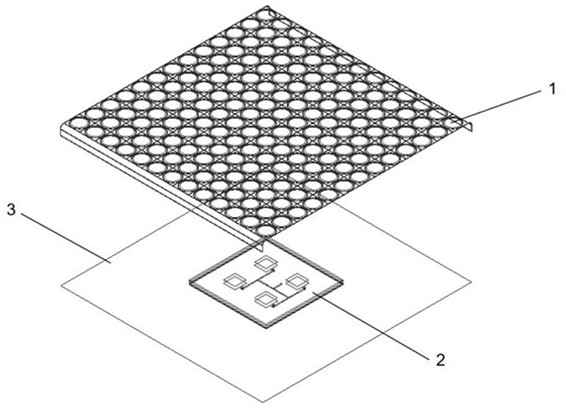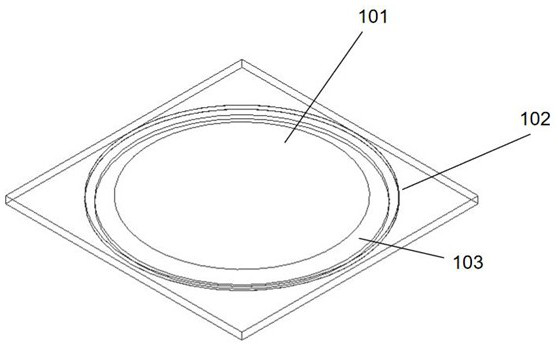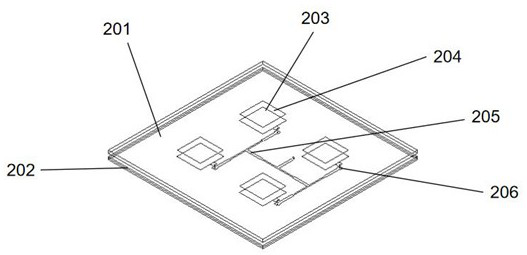[0004] The prior art is as follows: In 2018, literature [B. Gao, S. Huang, Z. Ren, Y. Chen and X.Wang, "Design and
Verification of an Integrated Free-Standing Thick-ScreenFSS
Radome," in IEEE Antennas and
Wireless Propagation Letters, vol. 17, no.9, pp. 1630-1634, Sept. 2018, doi: 10.1109 / LAWP. 2018. 2859232] proposed an all-metal bandpass FSS radome and constructed a 3- D model, the bandpass FSS radome has the advantages of high
passband transmittance and good
angular stability, but reduces the
gain of the antenna
[0005] In 2012, the patent [Beijing University of Aeronautics and
Astronautics. Optimization method for cross-shaped annular slot frequency selective surface
unit structure and its conformal low RCS radome: CN201210200659.2[P]. 2012-10-10.] proposed a The conformal low RCS radome with frequency selective performance has the
advantage that the electromagnetic wave can be transmitted well in the
passband, and the electromagnetic wave outside the band cannot be reflected back through the radome, but the radome has a single performance
[0006] In 2019, the patent [
South China University of Technology. Band-pass frequency selective
surface structure, shielding door and radome: CN201920583485.X[P]. 2019-11-15.] proposed a band-pass frequency selective
surface structure radome, It has the advantages of double zero point, good
frequency selection, small
insertion loss, and insensitivity to electromagnetic polarization, but its multi-layer structure is more complicated
[0007] In 2019, the patent [Tianjin Photoelectric Communication Technology Co., Ltd. A frequency selective surface radome: CN201822105652.8[P]. 2019-06-11.] designed a three-layer structure frequency surface radome, which has the
advantage of electromagnetic Good compatibility and can reduce out-of-band RCS, but the loss of the multi-layer structure is large and the structural strength is not enough
[0008] In 2018, literature [S. Wang, J. Hong, S. Liu and X. Li, "Design of an AntennaRadome Based on a Kind of
Graphene Frequency
Selective Surface," 2018International Conference on
Microwave and
Millimeter Wave Technology (ICMMT), Chengdu, 2018, pp.1-3, doi: 1109 / ICMMT.2018.8563651.] proposed a beam reconfigurable radome based on
graphene FSS, which can realize the selection of specific frequency bands for
bandpass filtering, but based on the
chemical potential of
graphene Controlling the structural characteristics of
frequency selection has the
disadvantage of being difficult to realize
[0009] In 2018, the patent [Xi'an Dianzi University. A conformal load-carrying antenna using FSS and micro heat pipes to achieve frontal heat dissipation: CN201711138277.0[P]. 2018-03-23.] proposed a method using FSS and metal heat conduction Conformal load-carrying antenna for tube heat dissipation. The device is composed of a
microstrip antenna and a wave-transmitting cover. The wave-transmitting cover is composed of a
skin and a core layer. A heat-conducting material is placed under the wave-transmitting cover, and FSS is placed above the
skin. The heat is transferred to the FSS in the
skin, using the external high-speed
airflow to achieve heat dissipation and has the function of
frequency selection, but the device is not connected to the antenna floor and only dissipates heat through the metal conduit in the radome. The structure is relatively complicated, and the working performance of the FSS is not analyzed.
[0010] In 2020, the patent [Xidian University. A
liquid metal-based reconfigurable frequency selection device for heat dissipation: CN202010208670.8[P]. 2020-08-07.] proposed a
liquid metal-based heat dissipation Frequency reconfigurable frequency selection device. The device has three
layers. There are
liquid metal inlets and outlets on the top and bottom, and there are frequency selection arrays on the top and bottom. The frequency selection can be reconfigured by injecting liquid metal; the bottom and top Each row of the frequency selection unit is aligned in the horizontal direction, and each column is aligned in the vertical direction. The wall panels are fixed around the frequency selection array on the top layer and the frequency selection array on the bottom layer, which reduces the heat accumulation on the surface of the radome and improves heat dissipation. Connected to the antenna floor and only dissipates heat through itself, and the frequency selection bandwidth is narrow
The patent designs a conformal load-carrying antenna with FSS and metal
heat pipe for heat dissipation. The metal
pipe and heat-conducting material are placed inside the radome, and only the radome itself is used to dissipate heat and the structure is complex, which will inevitably affect the frequency of the FSS placed above the skin. select performance
The patent designs a device based on liquid metal that can dissipate heat and reconfigurable frequency selection. By injecting liquid metal into the top and bottom of the device to achieve reconfigurable frequency selection, this method can reduce the heat accumulation on the surface of the radome and improve heat dissipation. The
disadvantage is that it only relies on the heat dissipation of the radome itself and the bandwidth of the frequency selection surface is too narrow
[0012] Through the above analysis, the existing problems and defects of the prior art are as follows: In the radome
design process based on FSS design in the prior art, the heat dissipation performance of the radome and the electromagnetic performance of the wire cover cannot be taken into consideration at the same time, and the Meet increasing communication demands
[0013] The difficulty of solving the above problems and defects is as follows: After the above analysis, modern common antenna systems use the radome itself to dissipate heat, and there are problems such as the structure of the radome itself is too complicated or the
wave transmission performance of the radome itself is not good enough. It is difficult to integrate the radome and the antenna structure. The radome FSS unit of the present invention has a large proportion of metal and has good
wave transmission characteristics and good heat dissipation performance. The radome with a high proportion of metal is integrated with the metal floor, and the electromagnetic and The heat dissipation performance has been well realized, and no obvious shortcomings have been found so far
[0014] The significance of solving the above problems and defects is that the
wave transmission characteristics and heat dissipation performance of the radome are very important indicators to be considered in the
base station antenna design. The existing frequency-selective radome with heat dissipation characteristics is too complicated in structure or the radome itself is transparent. The wave performance is not good enough, and at the same time, it cannot be integrated with the antenna structure to achieve better heat dissipation performance. The first innovation of the present invention is the FSS
unit structure with a high metal ratio, and the second innovation is to integrate the frequency selection radome with the floor. Better heat dissipation is achieved without affecting the performance of the antenna or even improving the performance of the antenna. The structure is simple and easy to process, and it is widely applicable to
base station antennas with high
power consumption Login to View More
Login to View More  Login to View More
Login to View More 


